Business Analyst Skill Requirements
| ✅ Paper Type: Free Essay | ✅ Subject: Personal Development |
| ✅ Wordcount: 3069 words | ✅ Published: 23 Sep 2019 |
Business Analyst Skill Requirements
Contents
Figure 2 U.S Bureau of Labor Statistics
Definition
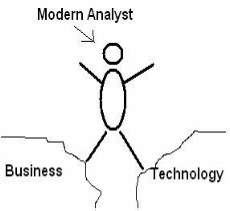 Every business needs to cut down cost and make money and technology helps them to achieve this goal. A Business Analyst (BA) bridges between the needs and the delivered solution. A BA is the skilled proficient who understand the business problems using business and analytical skills and also uses communication and technical competencies to work with the technical teams to develop & deliver a suitable solution on time.
Every business needs to cut down cost and make money and technology helps them to achieve this goal. A Business Analyst (BA) bridges between the needs and the delivered solution. A BA is the skilled proficient who understand the business problems using business and analytical skills and also uses communication and technical competencies to work with the technical teams to develop & deliver a suitable solution on time.
Business Analyst
Thus, according to BABOK 3.0 definition of BA in 2015 is stated as[1]: “A business analyst is any person who performs business analysis tasks described in the BABOK ® Guide, no matter their job title or organizational role.”
However, business analysis definition was significantly changed significantly[2]: “Business analysis is the practice of enabling change in an enterprise by defining needs and recommending solutions that deliver value to stakeholders.”
The major change with the new definition by IIBA here is the shift in the role of the BA from that of a liaison who recommends solution to the change enabler by focusing upon needs & solutions.
Evolution of BA role
Traditionally, the main role of Business Analyst was focussed around requirements gathering. About some decades ago, BA’s expect to progress into Project Management role to rise up in their career path. The key skills requirement included ability to interpret, summarise and document business requirements to fulfil project lifecycle and act as bridge between technology & business people and make the processes streamline.
In 2006, the two major organisations focusing on business analysis described BA through new definitions. First definition is provided in the BABOK Guide v1.6 by IIBA [3]as: “A business analyst works as a liaison among stakeholders in order to elicit, analyse, communicate and validate requirements for changes to business processes, policies and information systems. The business analyst understands business problems and opportunities in the context of the requirements and recommends solutions that enable the organization to achieve its goals.”
This definition closely relates business analysts to just requirements perspective which still exists today. The BA is considered to have understanding about processes, policies as well as information systems.
Second definition is provided by BCS (formerly British Computing Society)[4] as: “An internal consultancy role that has the responsibility for investigating business systems, identifying options for improving business systems and bridging the needs of the business with the use of IT.”
This is the first definition to step away from the requirements focus to a broader focus on business systems, but it still focused on IT and the BA as bridging role.
However, nowadays the trend is changing and solutions are getting digitalised, lean and agile, more empowered. The simpler projects of former times are no longer typical. There is a growing increase in complexity as we are moving towards technology and particularly in the area of big data, cloud computing, applications.
Organizations are producing more data than previously. Those who are able to draw insights from huge data and use it for telling stories are becoming popular. This creates the demand for BA to specialise & acquire skillsets in this area. One of the BA Mercy Obi[5], a based in Glasgow, Scotland, calls herself as a data storyteller and recommends that data is one of the leading areas of growth for business analysts currently. Therefore, the skills a BA can bring to the table can’t be ignored. The role of BA is changing, traditionally, it was about documenting & requirements management skill more, but today it is more about problem solving & customer-focused skills which ensures business values are maintained across all levels of organisation.
The need of BA continues to exist in delivery teams in order to ensure the balance between people, process & technology. The teams look upon BA for extra addons to make the deliverable more outstanding. With this mindset, it is true to mention that the role of BA is changing with time and now it is attracting more specialised roles such as Business architects and product owners.
Challenges
According to the academic research paper “A Survey on Identifying and Addressing Business Analysis Problems”[6] focused upon the challenges which lead to negative payoff on the performance of BA. Upon surveying different BA with varying experiences from major firms, below list of top 15 problems was prepared along with the frequency score of its occurrence.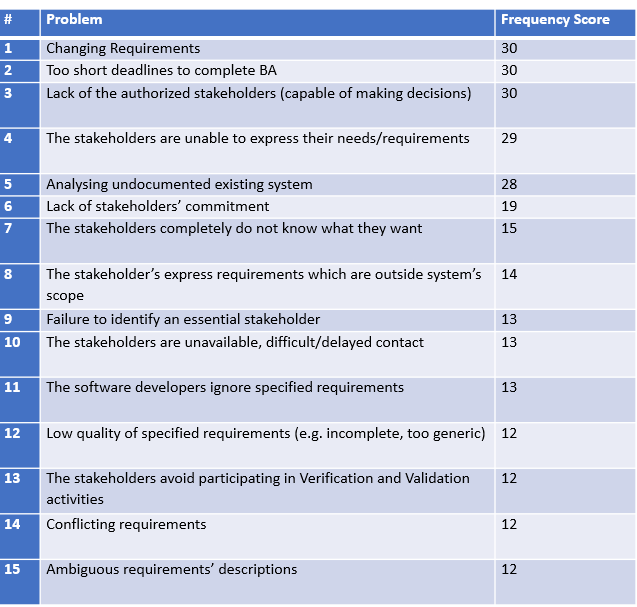
Thus, the major issues faced by BA can be organised as below based upon above paper research-
a) Stakeholder issues: –
The major challenge with stakeholders is that they don’t know what they want and have sometimes changing/missing requirements, or some hidden agendas, or lack of support from sponsors, and many more. Hence, it is difficult to build potential solutions.
b) Requirements challenges: –
The biggest challenges with requirements is that the requirements are constantly changing and leads to scope creep. Sometimes, stakeholders don’t have clarity upon requirement which leads to assumptions that are often invalid.
c) Solution related problems: –
There is a concern of premature solutioning in which solution are implemented instead of problem to solve. The uncertainness about projects and initiatives to organizational goals leads to make assumptions about the development & maintenance of solution, customers. Thus, making it difficult to align between solution and organisational strategy. Assumptions may cause efforts to fail if not properly validated.
d) Role related difficulties: –
With new technologies like Agile, BA are facing challenge to make their place in the organisation because various organizations are under the impression that they don’t need BA or Project Managers.
Opportunities for BA
With growing experience business analyst rise up the ladder of career. They can be pushed to roles like senior/lead business analyst, IT business analyst, or product manager after three to five years of experience. With more experience it is likely that BA will be assigned more complex/larger projects to work on. BA can also advance to CTO or work as a consultant after 8 to 10 years of experience. The Bureau of Labor Statistics illustrates that there will be about 34% increase statistical occupations by 2024 which is the highest average percentages among growing occupations.
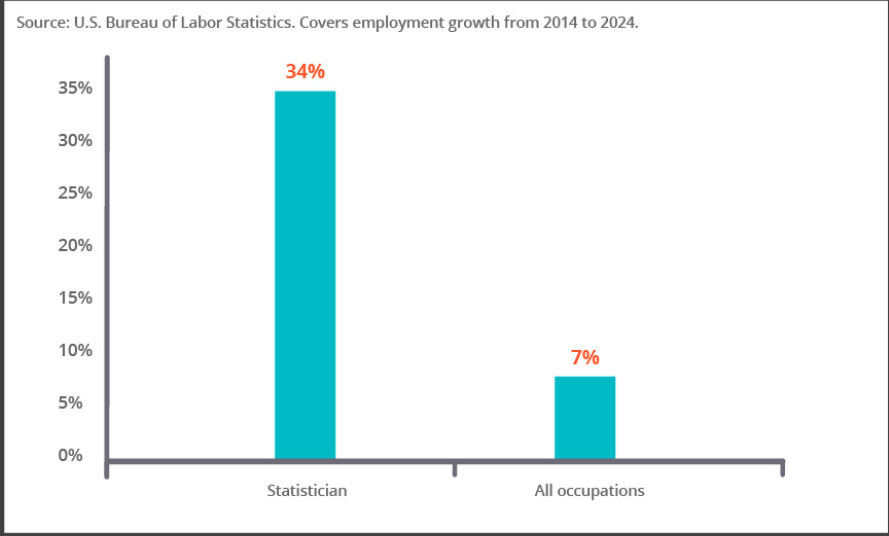
Figure 2 U.S Bureau of Labor Statistics
Some of the upcoming opportunities are discussed as below:
IT Business Analyst – The job description includes going beyond IT & software and including business components focusing on strategic aspect. Thus, it is the combination of both technology & business for managing corporate data. The average salary is $94,400-$120,000 USD.
Data Analysis Scientist – The job description involves to extract meaningful insights from the data which requires statistics and machine learning and thinking out of box. The average salary is $130,300 USD.
Business Analyst Manager – This role requires a graduate degree in either finance or business administration and an experience as a general business analyst. Further, a postgrad degree in Business Administration is expected for high end jobs. The average salary is $70,170 USD.
Quantitative Analyst – A QA develops, implements and demonstrate mathematical models to support financial decisions on pricing structures, investments, and risk management. For this job a master’s degree or PhD in mathematics, economics, financial engineering, or computational finance is mandatory. The average salary is $63,000-$126,000 USD.
Data Business Analyst – This role involves working with larger datasets to identify trends, develop charts, and create visual presentations for making business decisions. It also involves monitoring the hardware, software, and IT services for a business. The average salary is $77,500 – $ 100,000 USD.
Techniques & Skillsets
According to Forrester analyst Mary Gerush report [7], while strong abilities in fundamental skills like communication, collaboration and analysis are always considered to be mainstays of BA, the changing technology and agile approaches are altering the skillsets of BA world.
Therefore, it has become important for today’s BA to have a combination of fundamental, technical and analytical skillsets in order to sustain in the changing world. The skillsets are defined more in detail below-
Fundamental Skill
- Problem Solving: A BA must completely understand and analyse the problem from different perspective, consider various constraints and then should recommend the potential as well as alternative solutions. This requires use of techniques like Brainstorming, Five Whys to reach to the main point of the problem and come up with the solution.
- Communication: There are several modes of communication in an organisation like emails, documents, meetings, skype calls, video conferencing, chats and many more. Thus, a BA needs to be clear, expressive, concise in the communication. An effective communication also involves active listening to understand what is being told.
- Management Skill: A BA is responsible for several tasks like requirement gathering, approvals, documenting, testing, attending meetings, some ad-hoc tasks as well as managing the project completely. Thus, it becomes important for BA to acquire management skill in order to balance the tasks and deadlines.
-
Research: The fact that Business Analysts are problem solvers and they dig into problems to recommend solutions, itself makes it self-explanatory that research is one of the important skillsets for an analyst.
Technical Skill
- Knowledge of IT skills: Acting as a bridge between developers and clients,a BA is expected to be technically sound and should be aware of various IT areas such as – Database, programming languages, office suite, operating systems, testing environment in the market.
- Domain Knowledge: A BA must be informed of the domain he/she works in and be aware about the business case of the project in order to solve domain specific problem.
Business Analysis Skill
- Requirement Elicitation: Requirement Elicitation means to draw out.BA are required to gather the requirements from stakeholders using techniques like interviewing, workshops, brainstorming, observation. In order to do rightly, it is important for BA to know when to use which type of technique and not to jump into conclusions quickly without considering scenarios.
- Documentation: A BA is required to document correct, upto date and unambiguous requirements from stakeholders using any of the technique like ER diagram, use cases, user stories, class diagram, sequence diagram, etc
- Decision Making: A BA is member of decision-making forums and meetings like requirement prioritization discussion, implementation discussions, change control board, planning meetings, etc. Therefore, it is required for a BA to make balanced and well-thought decisions using different techniques such as impact analysis, comparative analysis.
-
Analytical Skills: It involves an investigative approach, logical thinking, problem handling and interpretation skills to solve every business problem analytically.
Pressure faced by BA
According to the conference paper by Pullan Penny in 2015 states that there is an overlapping relationship between Project Manager (PM) and BA. Hence, a friction exists between PM, BA & organisation which can be solved with good communication, respect, trust, mutual understanding, rapport.
The focus of PM is towards the scope of the project, i.e. the amount of efforts needed to complete & deliver the end result. However, the focus of BA is towards the scope of the solution, i.e. what will be the final solution look like. Both have different roles but they share some overlapping perspectives as illustrated in below figure.
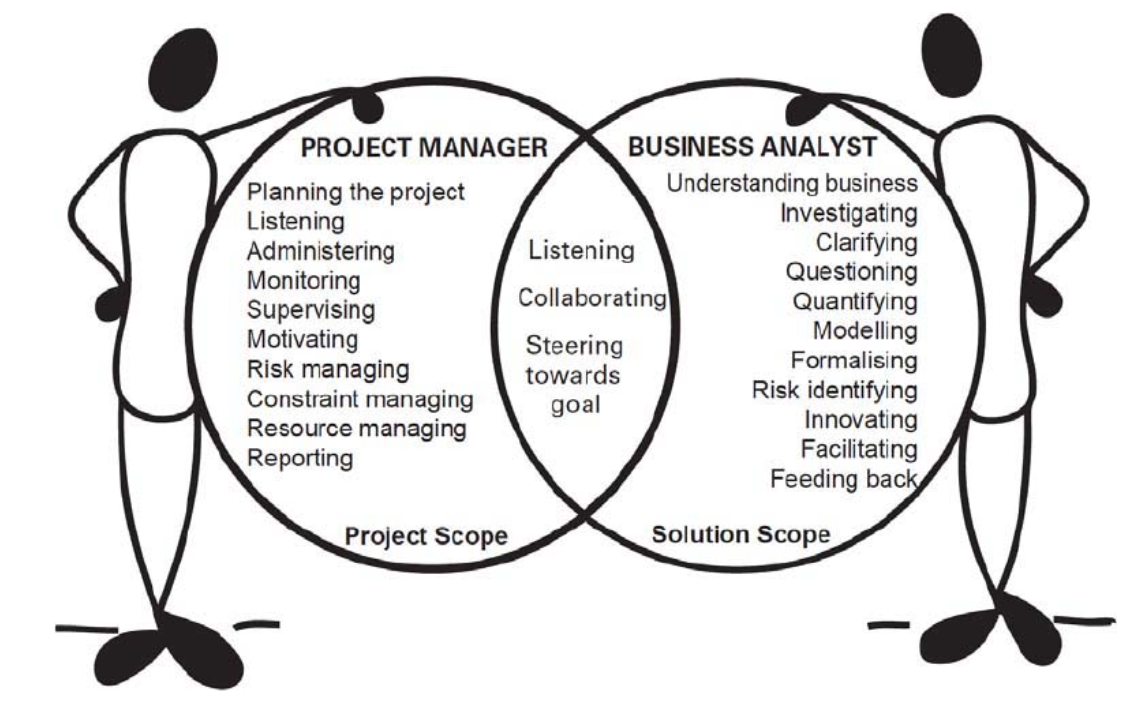
The relationship between two has changed drastically with time. Earlier, BA used to be the junior team member and had reporting under PM. Nowadays, BA can rise to different strategic positions within the organisation while staying away from PM role throughout their career. Hence, both roles have acquired leadership role in themselves, so this can be difficult for PM and give rise to tensions/pressure as PM are used to older practices.
Also, as we all know management is always under the pressure of reducing delivery time, cost and not always ready to invest into thorough analysis of the processes. Therefore, PM usually has their own opinion about changes to put into place and have their own perception which is not always true in reality. Therefore, the BA feels a pressure from PM side as they are not ready to listen to what BA has to say and on the other hand BA has to find a way to soften the information at the right time. If a system is put to production and fails to meet the needs of the business, the BA may end up being blamed for the outcome. That’s why BAs are constantly under pressure.
On the other side, employees often feel that they are being assessed while in fact it is the study of organisation processes. Therefore, a BA has the pressure to earn the employee’s trust so that he/she can learn more about the problems they face at work. Hence, it can be stated that BA often feel pressured to prove their relevance.
In order to overcome so, activities like lunch & learn can be planned in organisation which a fun and informal method to promote employee engagement, stimulate energy & creativity at workplace and get chance for involvement into business.
Communication is the key to success. It should be determined that both PM &BA have the same understanding about the project objective and are aware about the progress, regular updates, risks, health checks. Honesty & transparency should be followed in the organisation.
Various stages of a BA role
BA is a multistage process for identifying and defining the requirements that must be fulfilled to obtain ‘business objectives. It is carried out in every project irrespective of project size, complexity, industry or type. 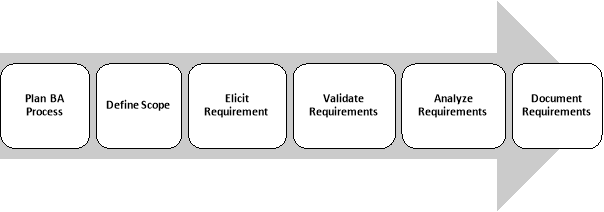
- Plan BA Process: It involves the steps followed to conduct the business analysis such as templates for documents, listing stakeholders, requirement management plan, details of shared location for storing documents, mode of communication, etc. If planning is followed & done properly than it leads to overall success of the project.
- Define Scope: It involves defining the scope statement stating the acceptance criteria of the project so as to consider the project to be completed or successful. It involves all deliverables, constraints, assumptions.
- Elicit Requirement: Eliciting involves gathering as much information as possible about the requirements that needs to be developed by communicating with the stakeholders and spending an ample amount of time to comprehend the demands and making sure no requirement is missed out.
- Validate Requirement: The gathered requirement must be validated against business case for feasibility. Some requirements which are out of scope of project, or have technical constraints must be highlighted and workarounds must be discussed and agreed upon with the clients.
- Analyse Requirement: It involves the steps required to achieve the gathered requirements using data model, process flow diagram, prioritizing the requirements and establishing the interdependencies between them, etc.
- Document Requirement: The final step is documenting the requirements which involves technical knowledge and writing skills and the document must be approved and validated by the key stakeholders.
Bibliography
- Pullan, P. (2018). The Changing Role of the Business Analyst – PMO Perspectives Blog. [online] PMO Perspectives Blog. Available at: https://www.strategyex.co.uk/blog/pmoperspectives/business-analysis-the-changing-role-of-the-business-analyst/
- Budler, A. (2017). Linking to Trends – Trend 4: The changing role of the BA – Analyze. [online] Analyze. Available at: http://analyze.co.za/linking-trends-trend-4-changing-role-ba/
- Olson, D. (2017). The Role of the Business Analyst – It’s Time for a New Perspective | BAwiki. [online] Bawiki.com. Available at: http://bawiki.com/thoughts/the-role-of-the-business-analyst-its-time-for-a-new-perspective/
- Saboe, D. (2018). Common Issues Facing Business Analysts. [online] Mastering Business Analysis. Available at: http://masteringbusinessanalysis.com/lightning-cast-common-issues-facing-business-analysts-today/
- Collabera. (2019). 5 In-Demand Career Paths for Business Analysts. [online] Available at: https://www.collabera.com/find-a-job/career-resources/5-in-demand-career-paths-for-business-analysts/
- Thebusinessanalystjobdescription.com. (2019). Key skills that every Business Analyst must know | The Business Analyst Job Description. [online] Available at: https://thebusinessanalystjobdescription.com/key-skills-that-every-business-analyst-must-know/
- Jarzębowicz, A. & Marciniak, P. 2017, “A Survey on Identifying and Addressing Business Analysis Problems”, Foundations of Computing and Decision Sciences, vol. 42, no. 4, pp. 315-337.
- Pullan, P. (2015). Business analysis/project management friction, and how to overcome it. Paper presented at PMI® Global Congress 2015—EMEA, London, England. Newtown Square, PA: Project Management Institute.
- Poirier, P. (2017). How to Handle Pressure as a Business Analyst? | BAjobs.ca. [online] BAjobs.ca. Available at: https://www.bajobs.ca/en/how-to-handle-pressure-as-a-business-analyst/
- Thebusinessanalystjobdescription.com. (2019). Learn how to do ‘Business Analysis’ in 6 Processes | The Business Analyst Job Description. [online] Available at: https://thebusinessanalystjobdescription.com/business-analysis/
- BABOK Guide v3.0. Section 1.3 – Who is a Business Analyst? IIBA. 2015.
- BABOK Guide v1.6, Section 1.4.1, Definition of the Business Analyst Role. IIBA. 2006.
- Business Analysis events presentation. By Paul Turner and Debbie Paul. 2006.
- Gerush, M., S.Hammond, J. and D’Silva, D. (2009). Your 2009 Business Analysts: Know Them To Grow Them. [online] Forrester.com. Available at: https://www.forrester.com/report/Your+2009+Business+Analysts+Know+Them+To+Grow+Them/-/E-RES48340?docid=48340#
- En.wikibooks.org. (2014). Template:Business Analysis Guidebook/Print version – Wikibooks, open books for an open world. [online] Available at: https://en.wikibooks.org/wiki/Template:Business_Analysis_Guidebook/Print_version [Accessed 23 Feb. 2019].
[1] BABOK Guide v3.0. Section 1.3 – Who is a Business Analyst? IIBA. 2015.
[2] BABOK Guide v3.0. Section 1.3 – Who is a Business Analyst? IIBA. 2015.
[3]BABOK Guide v1.6, Section 1.4.1, Definition of the Business Analyst Role. IIBA. 2006.
[4] Business Analysis events presentation. By Paul Turner and Debbie Paul. 2006.
[5] https://www.linkedin.com/in/mercyobi/?originalSubdomain=uk
[6] Jarzębowicz, A. & Marciniak, P. 2017
[7] Gerush, M., S.Hammond, J. and D’Silva, D. (2009). Your 2009 Business Analysts: Know Them To Grow Them. Forrester.com. Available at: https://www.forrester.com/report/Your+2009+Business+Analysts+Know+Them+To+Grow+Them/-/E-RES48340?docid=48340#
Cite This Work
To export a reference to this article please select a referencing stye below:
Related Services
View allDMCA / Removal Request
If you are the original writer of this essay and no longer wish to have your work published on UKEssays.com then please click the following link to email our support team:
Request essay removal



